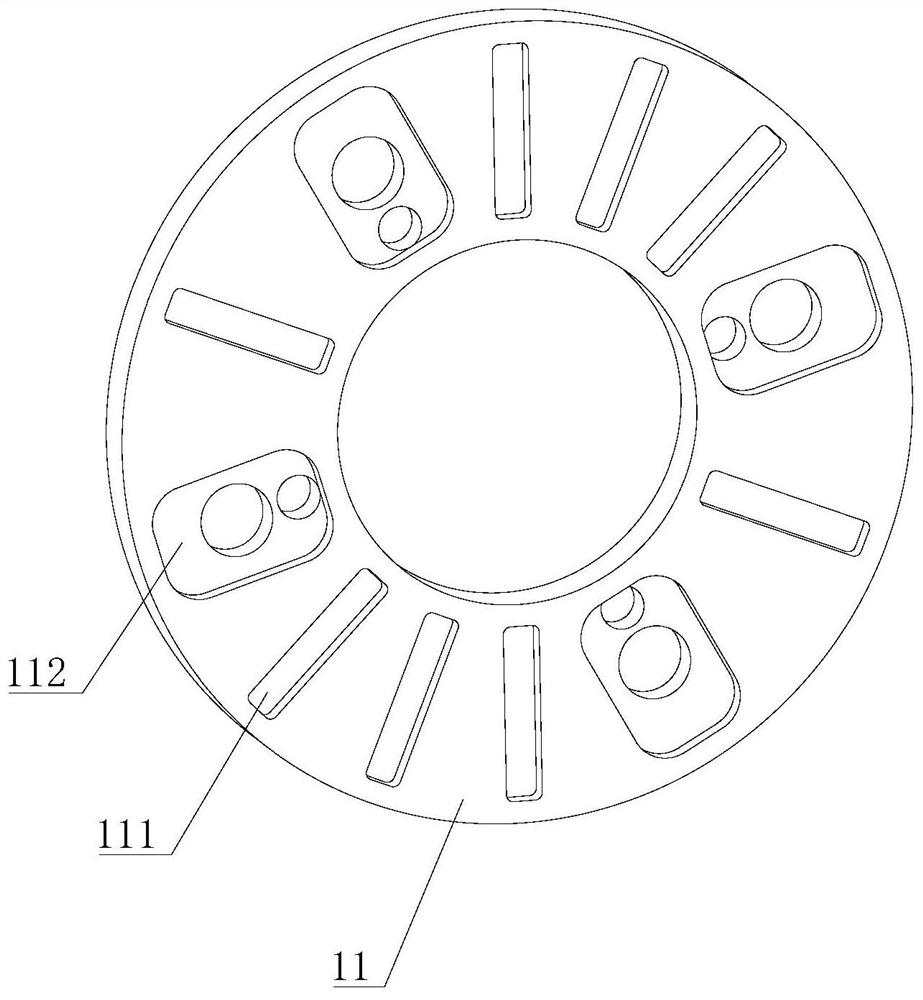Heat dissipation structure, power take-off mechanism and crane
A heat dissipation structure and crane technology, applied in mechanical equipment, transmission parts, belts/chains/gears, etc., can solve the problems of shortened service life of power transmission shafts, prolong service life, reduce possibility, and reduce temperature rise The magnitude of the effect
- Summary
- Abstract
- Description
- Claims
- Application Information
AI Technical Summary
Problems solved by technology
Method used
Image
Examples
Embodiment 1
[0043] Please also refer to Figure 1 to Figure 4 , this embodiment provides a heat dissipation structure applied to a power take-off mechanism, including a heat-resistant element 1 . The heat resistance element 1 is composed of two end plates 11 and a plurality of cooling plates 12, and is connected with the power take-off device 4 and the power take-off drive shaft 5 of the power take-off mechanism.
[0044] The two end plates 11 are both ring-shaped, and the axes of the two end plates 11 coincide with the axis of the power take-off transmission shaft 5, one of the end plates 11 is connected with the power take-off 4, and the other end plate 11 is connected with the power take-off transmission shaft 5. Axis 5 is connected. The cooling plates 12 are located between the two end plates 11 , and each cooling plate 12 is perpendicular to the end plates 11 , arranged along the radial direction of the end plates 11 , and arranged along the circumferential direction of the end plat...
Embodiment 2
[0069] Please also refer to Figure 7 to Figure 9 , the difference from Embodiment 1 is that the heat dissipation structure further includes a plurality of first fan blades 2 .
[0070] Specifically, the number of first fan blades 2 is ten. Each first fan blade 2 is fixed on the outer wall of the heat-resisting element 1 , rotates with the heat-resisting element 1 , and generates an airflow along the axis of the power-taking transmission shaft 5 .
[0071] The airflow flows from the power take-off transmission shaft 5 to the power take-off 4, first passes through the cross shaft of the power take-off transmission shaft 5 towards the end of the power take-off 4, and takes away the heat on the cross shaft, then flows to the power take-off 4, and further takes away Heat on PTO 4.
[0072] After the first fan blade 2 is installed, the power take-off transmission shaft 5 is actively dissipated, so that the temperature rise of the cross shaft end covers at both ends of the power t...
Embodiment 3
[0083] see Figure 10 , the difference from Embodiment 1 is that the heat dissipation structure further includes a plurality of second fan blades 3 .
[0084] Specifically, the number of second fan blades 3 is 10, and the second fan blades 3 are fixed on the side wall of the power take-off transmission shaft 5 .
[0085] Common fixing methods include welding fixing and pin fixing. If the second fan blade 3 is fixed on the power take-off transmission shaft 5 by welding, the second fan blade 3 is not easy to disassemble and replace. If the fan blade 3 is fixed on the power take-off transmission shaft 5 , holes need to be drilled on the power take-off transmission shaft 5 , which will affect the structural strength of the power take-off transmission shaft 5 .
[0086] In order to make the second fan blade 3 easy to disassemble and avoid affecting the structural strength of the power take-off transmission shaft 5, in this embodiment, the second fan blade 3 is connected to the pow...
PUM
 Login to View More
Login to View More Abstract
Description
Claims
Application Information
 Login to View More
Login to View More - R&D
- Intellectual Property
- Life Sciences
- Materials
- Tech Scout
- Unparalleled Data Quality
- Higher Quality Content
- 60% Fewer Hallucinations
Browse by: Latest US Patents, China's latest patents, Technical Efficacy Thesaurus, Application Domain, Technology Topic, Popular Technical Reports.
© 2025 PatSnap. All rights reserved.Legal|Privacy policy|Modern Slavery Act Transparency Statement|Sitemap|About US| Contact US: help@patsnap.com



